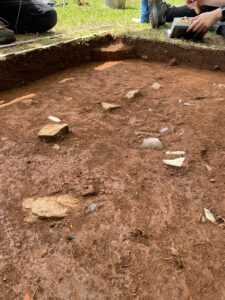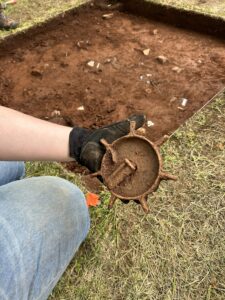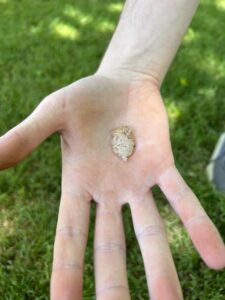Archaeology Blog
2023 Field School Week 2
By: Cameron Cash
This was an exciting week for the 2023 Archaeology Field School. Despite Monday’s inclement weather keeping us away from our 5 ft. x 5 ft. excavation units by the 1857 Slave Dwelling, the students were given a few fantastic lectures by Karen McIlvoy and Erin Schwartz. The students learned about the origins, materials, manufacturing processes, and utility of various types of ceramics, glassware, tobacco pipes, and metal objects. These lectures helped the students identify many of the artifacts they had been finding.
Students got their first experience in the archaeology lab on Tuesday and Wednesday. This week’s lab work focused on two skills: cleaning artifacts and flotation picking. When an artifact sits in the ground for hundreds of years, it can rust and become caked with dirt. When we scrub the artifact (although not too hard), we are better able to see its distinguishing features. These features can help identify where and when the artifact came from. Flotation picking is also very important. All of the soil we dig out of our units is pushed through a screen before being dumped. However, there can be artifacts so small that they go right through it. Picking allows us to grab smaller pieces from soil samples with tweezers so that they can also be catalogued.
While half of the students worked in the lab, the other half remained hard at work in the field by the 1857 Slave Dwelling. Fieldwork this week was particularly interesting as we dug through the midden layer. In the past, people would regularly dump their trash out behind their home, and this was no exception. Students were making multiple artifact bags for a mere few inches of soil dug down. We found glass of a wide range of colors, large pieces of plates of various patterns and colors, the bowl of a tobacco pipe, and many iron tools and pieces, among others. One student even found a stone projectile point made and used by Virginia Indians. The discovery of a maker’s mark on some of the pieces can be incredibly helpful for determining when the artifact was made.
One of the more exciting aspects of the week was the first Tuesday Tour at Poplar Forest, which focuses more closely on the archaeological work being done here. Through this tour, the students were able to interact directly with the public and talk to them about the amazing things they had been finding. The students loved showing people all of their interesting finds and look forward to the future Tuesday Tours and Archaeology Day (6/24) to teach the public all about the exciting excavations going on at Poplar Forest this summer.


